North Star Metrics: a framework for creating value
How to generate enduring value for your product and win the long game
Today's successful tech companies use North Star Metrics (NSM) to align the organization around delivering value to customers. Increasing NSMs is a testament to the business delivering value and ultimately generating revenue.
To reach their North Star Metric, organizations have to understand why they are valuable, how they can continue being valuable, and what measurable tasks they need to add to their value.
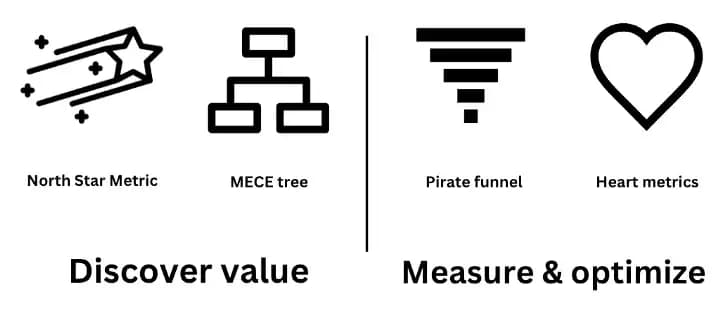
Icon sources — North Star Metric (opens in a new tab), MECE Tree (opens in a new tab), Pirate Funnel (opens in a new tab), Heart Metrics (opens in a new tab)
I recently asked myself how my writing could be most valuable, I wanted to share the frameworks I used and how I concluded with moving from Medium to Substack.
This post will demonstrate
- How to use the North Star Metric to discover value
- How to use Amplitudes North Star Framework & MECE trees to find actionable work to build toward your NSM
- How to measure your progress with the pirate funnel and HEART metrics
Discovering your value with the North Star Metric
Delivering value is akin to a product or service solving a customer need. The bigger problem the product solves, the higher the product's perceived value.
What is a North Star Metric?
North Star Metrics (NSM) are used by product-led companies to rally the whole company around a joint goal. The goal relates to delivering value to customers and/or generating company revenue.
NSM measures progress towards a mission & value creation
Generally, founders start tech companies because of a vision of the future and the mission they're on to get there. Mostly, they're successful because their mission correlates to delivering value to a customer or end user.
As demonstrated below, the company's North Star Metric is a tangible method to track a company's progress towards its mission and hence, towards value creation.
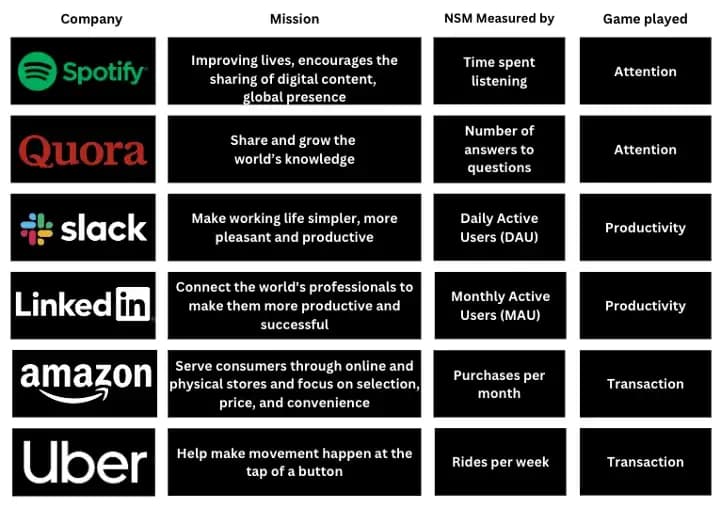
Mission & NSM as of September 2022. Game Played is assumed.
Finding your North Star Metric
This section will touch on 4 steps you can go through to find your own NSM
#1 Find your mission
Your mission is your reason why. If you need help understanding your mission and vision, Atlassian's playbook (opens in a new tab) is a great place to start.
#2 Find what game you're looking to play
Amplitude's North Star Playbook (opens in a new tab) categorizes companies according to 3 different focuses their NSM focuses on
- Attention: characterized by time and attention users spend on the product, demonstrated by Quora — Attention is quantified by a user reading questions and having the initiative to answer
- Productivity: characterized by the impact on productivity and efficiency users have when using the service, products like Slack are expected to be used daily, hence measured for Daily Active Users. LinkedIn isn't an enterprise tool required for day-to-day work (for most) and hence not expected to be used daily, hence, measured for Monthly Active Users.
- Transaction: characterized by the transactions through a product, Amazon measures monthly purchases, and Uber measures weekly purchases
NB: Lenny Rachitsky (opens in a new tab) described 6 categories on Future.com (opens in a new tab), similar, and worth a read.
#3 Synthesize
As an exercise, I'll look to create NSMs for blogs from Lifehack, Gary Vee, and Silicon Valley Product Group. Creating NSMs for other companies can break the ice on the exercise prior to your own NSM.
To find their mission, I matched the common reasons to run a blog (by Huffpost (opens in a new tab), Lifehack (opens in a new tab), Hubspot (opens in a new tab)) with a few blogs themselves.
- Build a brand
- Build report and engagement (online community)
- Learn new skills and improve your writing
- Share information about a given topic and establish authority as an expert
- Attract visitors to your site, and turn those visitors into leads
Piecing this together
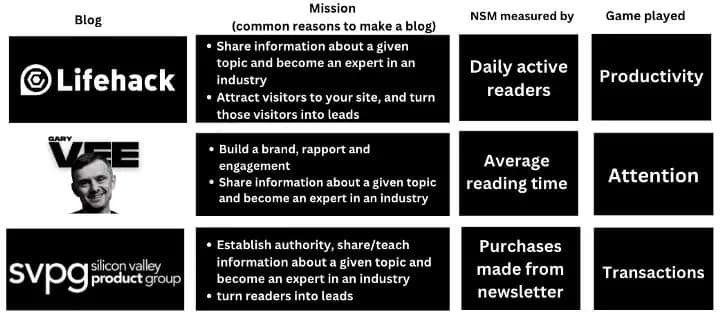
Synthesised NSM for Lifehack (opens in a new tab), Gary Vaynerchuck (opens in a new tab) and Silicon Valley Product Group (opens in a new tab)
#4 Find your value
My writing goal is to produce content that's clear in thought, easy to follow and engaging. Eventually, I'd love to sew a series of blog posts together as a course on product & Web 3. Here's what my NSM looks like:

Why did I choose the Attention game? If you're willing to pay attention and read my blog, I think that correlates to the quality of my articles and a targetted market of product or web3-focused readers. The next section will show you what metrics I can use to ensure that's true.
#5 Review, align and refine
Ensure your North Star Metric aligns with some/all of the below, if not, you can review and refine:
- Actionable and measurable
- Represents value to customers
- Represents your vision
- Gives the organization purpose to work and build together
Ensure your North Star Metric relates to helping customers achieve something.
Jobs-to-be-done framework (opens in a new tab) mantra is “People buy products and services to get a job done”. Aligning your NSM to support that ensures your product is solving a need and your growth will align to delivering more value to customers
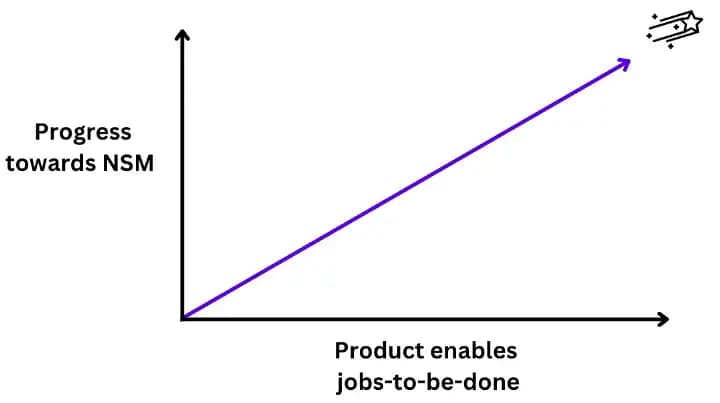
NSMs aren't immediately actionable — Here are 2 frameworks that are
Once you've settled on your North Star Metric, finding the underlying tasks and metrics that build up to the North Star is the next challenge.
Amplitudes North Star Playbook
Amplitudes North Star Playbook (opens in a new tab) is an invaluable resource for creating a North Star Metric. Their strategy starts with the North Star Metric, illustrating the inputs 3) and actions 4) needed to move your NSM forwards to achieve results 2).
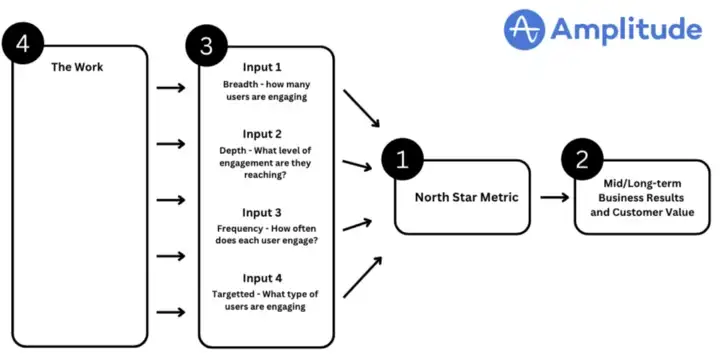
Duolingo example: Duolingo is an interesting example because they have multiple NSMs. Here's my breakdown of input metrics 3) and work required 4) to achieve the inputs.
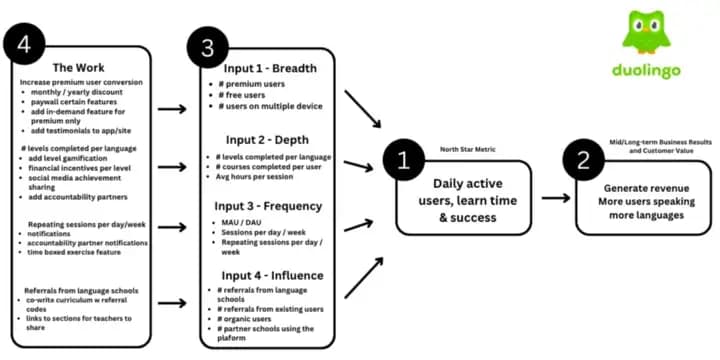
My blog example (below): this was an interesting exercise, I realized Medium's paywall could be restricting growth towards my North Star, and I realized I needed to further focus niche my articles towards my targetted readers, which is inline with my personal interests.
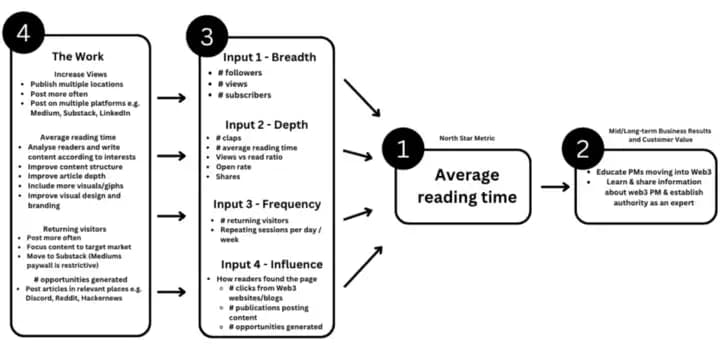
MECE trees
MECE trees (also known as issue trees) are a great way to break a problem down into smaller problems to find root causes. In these examples, MECE trees break the NSM down into measurable metrics and actionable tasks.
Football example
Mutually Exclusive (opens in a new tab): 2 events that can't happen at the same time. e.g.
- 2 different football teams winning the same match
Collectively Exhaustive (opens in a new tab): at least one defined result must occur. e.g.
- A collectively exhaustive list of results for a football match includes winning, losing, forfeiting, and tie
- A non-collectively exhaustive list of results is winning, losing, and forfeiting. If a team ties, it's not in the list of results
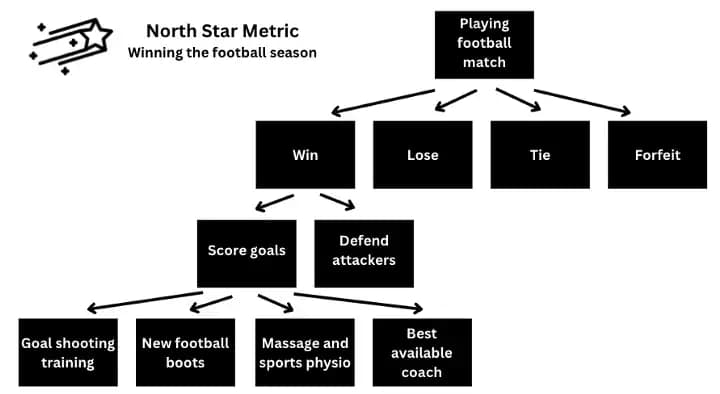
My blog example
My MECE tree starts with the NSM at the top, then a series of actions that progresses upwards towards the NSM. Actions closest to the top should send a clear signal to the NSM and should be measurable as primary metrics.
Continue moving down the tree, and each subsequent action should continue feeding its parent, the primary metric, whilst also being measurable as secondary metrics.
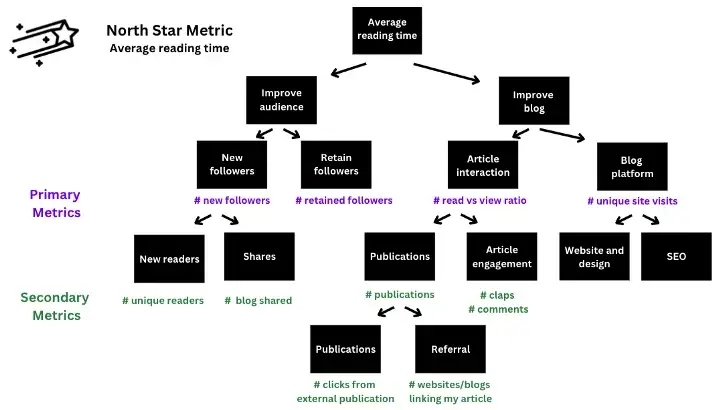
Measuring
🏴☠️ Pirate funnel AAARRR
The pirate funnel follows the customer from acquisition to purchase, generally used for optimizing SaaS product growth.
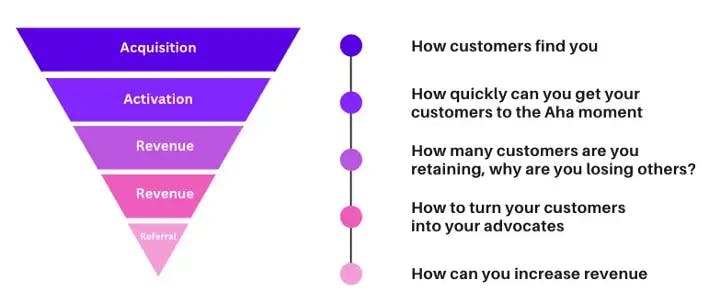
Both the North Star Playbook and MECE trees provide actions to complete to progress towards the north star. The pirate funnel breaks the customer journey down to identify specifically what should be tested first. e.g.
- Task: improve article engagement
- Analysis: how many articles are viewed compared to reads, comments, and shares. Which articles are performing and which aren't. Why?
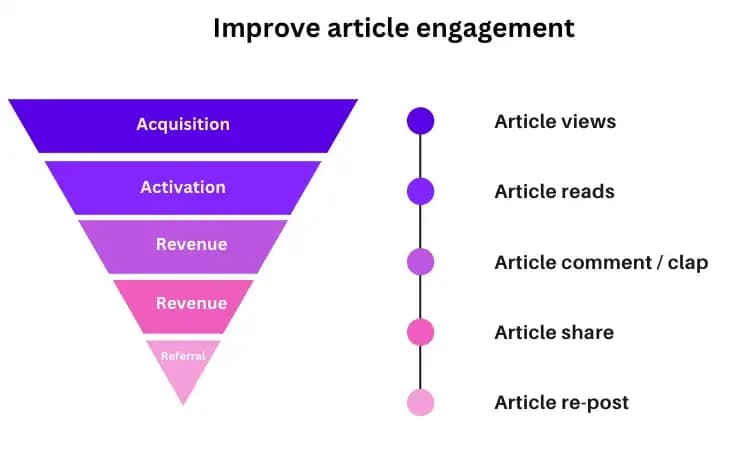
- Task: increase blog following by 100 followers per month
- Analysis: how many site visits vs follows, where are the site visits from, what sort of demographic can I see?
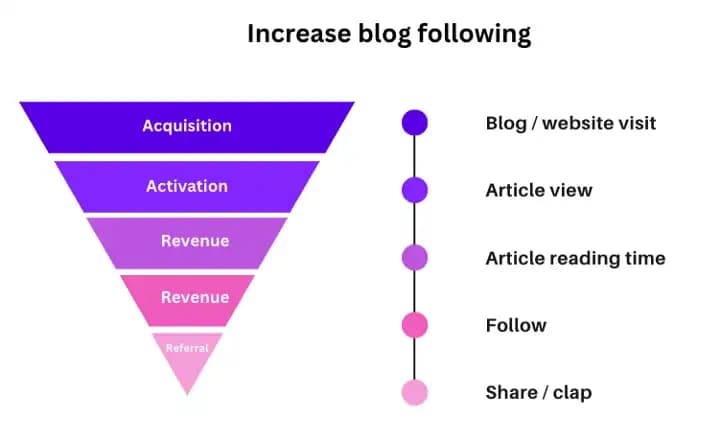
Why use the pirate funnel?
North Star Metrics often represent growth — in revenue, customers, consumption, engagement, and value. The pirate funnel narrows in on where the current efforts are failing — i.e. what to focus on.
❤️ Heart Metrics
Google introduced HEART metrics in 2010 to their growing need to measure user experience to direct product teams to measure progress towards a goal.
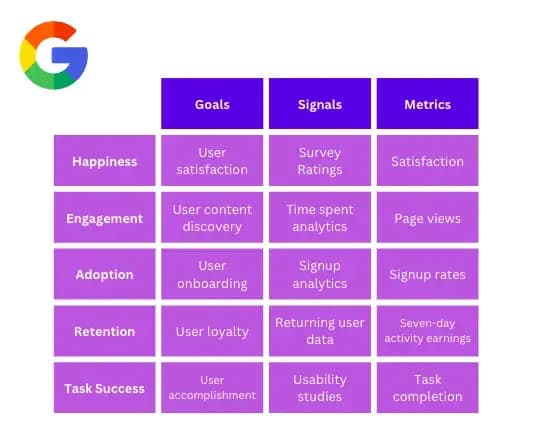
Google's HEART Metrics, source (opens in a new tab)
HEARTs goals, signals and metrics
- Goals: similar to the mission described in the NSM section, what's the product wanting to achieve?
- Signals: what are the leading/lagging indicators of success (or failure)
- Metrics: how do you measure the signal vs noise
HEARTs Happiness, Engagement, Adoption, Retention, Task Success
- Happiness: subjective user experience happiness levels
- Engagement: level of involvement with the product
- Adoption and retention: coming and going users
- Task success: user experience, task efficiency
Duolingo example
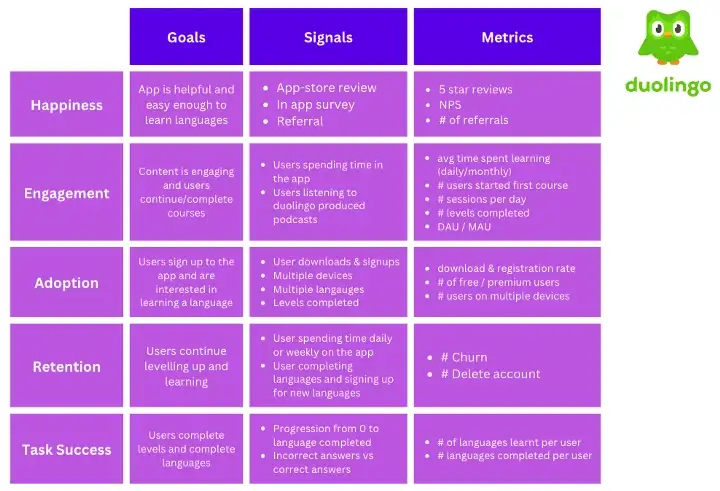
My blog example
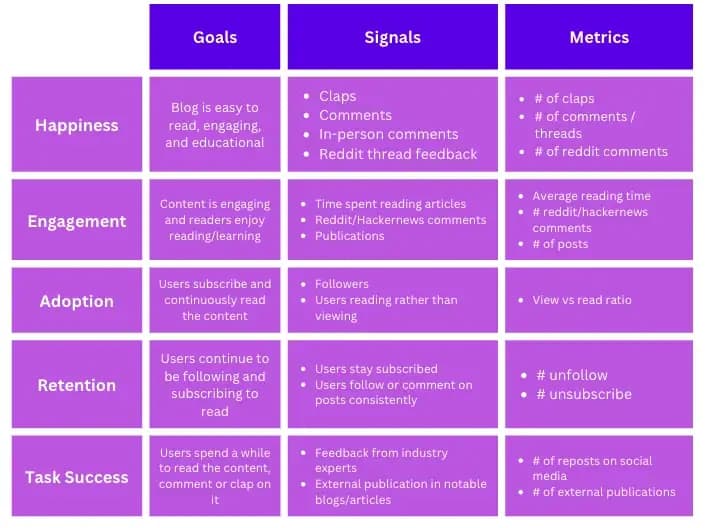
Why use HEART metrics?
In addition to the metrics identified using the pirate funnel — I believe HEART metrics
- Highlights the subjective nature users have towards technology
- Paints the full picture of what a successful user is and how to measure it
- Prioritizes user interaction and experience
Guardrails
Guardrails are just as important as goals. Guardrails measure what success doesn't look like — ensuring focus is set correctly on value whilst highlighting an awareness of a competing, vanity metric.
In the example below I've included guardrails I'd look out for in my blog.
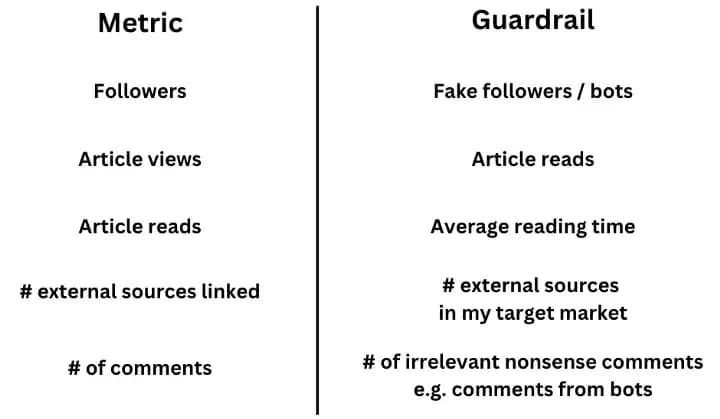
Why use guardrails?
Take a popular social media metric — Followers.
Followers don't necessarily relate to writing great content; writing relevant content, or whether you're improving your writing skills. Without an NSM, I could simply buy a few thousand followers from a service like Socialstore and claim progress towards my NSM.
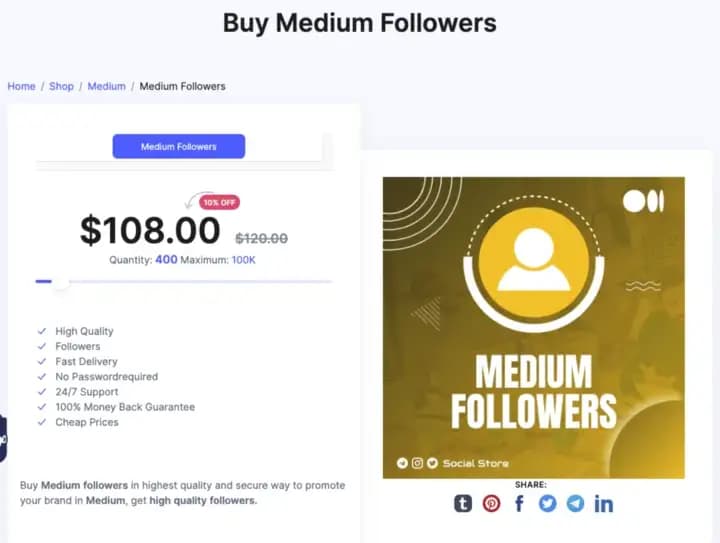
Socialstore (opens in a new tab) — buy Medium followers
Conclusion
If you've read this far, you will have followed my own search for value. North Star Metrics and a handful of product frameworks helped me realize
- What I wanted to achieve through writing
- Why readers would read my content
- Mediums paywall may be limiting growth towards my NSM
- How to measure success and nonsuccess
With a newly directed focus, I'm excited for what's next.